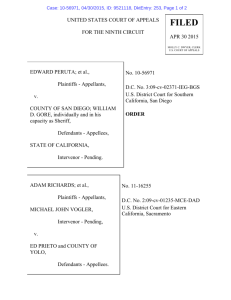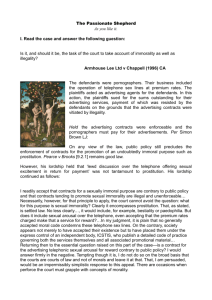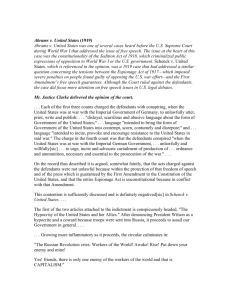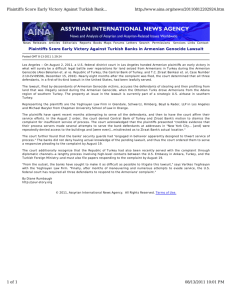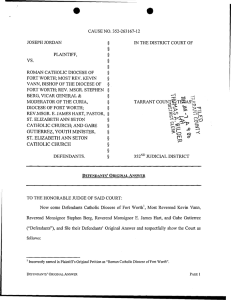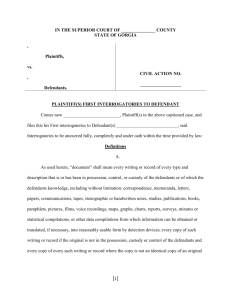- Electronic Discovery Law
advertisement
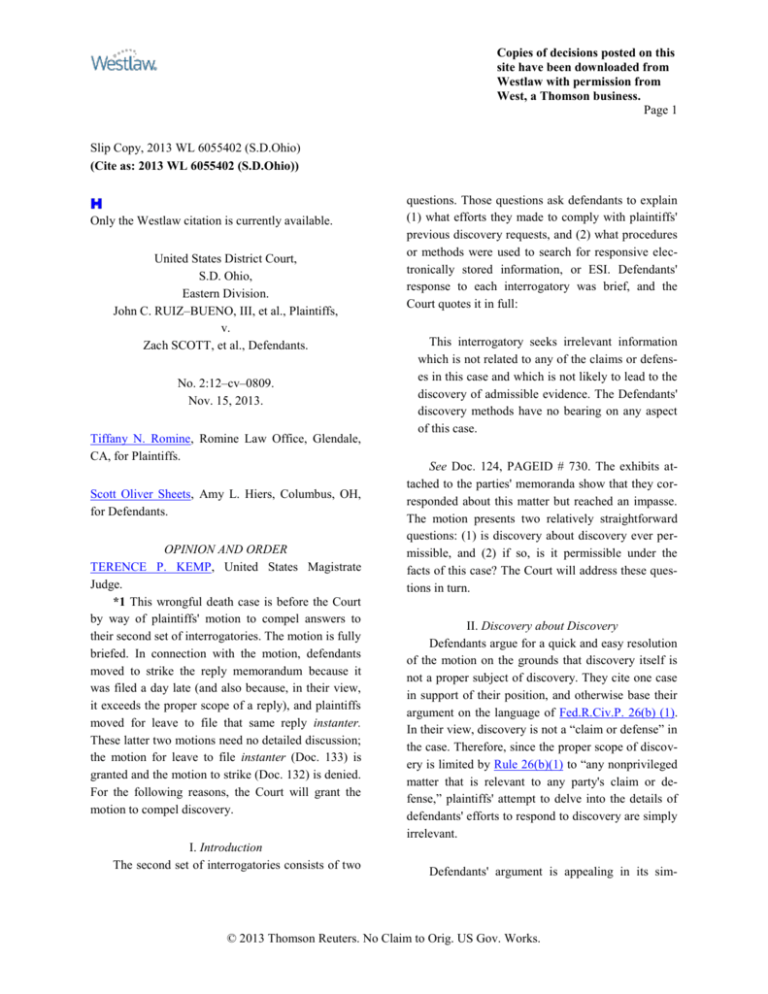
Copies of decisions posted on this site have been downloaded from Westlaw with permission from West, a Thomson business. Page 1 Slip Copy, 2013 WL 6055402 (S.D.Ohio) (Cite as: 2013 WL 6055402 (S.D.Ohio)) Only the Westlaw citation is currently available. United States District Court, S.D. Ohio, Eastern Division. John C. RUIZ–BUENO, III, et al., Plaintiffs, v. Zach SCOTT, et al., Defendants. No. 2:12–cv–0809. Nov. 15, 2013. Tiffany N. Romine, Romine Law Office, Glendale, CA, for Plaintiffs. Scott Oliver Sheets, Amy L. Hiers, Columbus, OH, for Defendants. OPINION AND ORDER TERENCE P. KEMP, United States Magistrate Judge. *1 This wrongful death case is before the Court by way of plaintiffs' motion to compel answers to their second set of interrogatories. The motion is fully briefed. In connection with the motion, defendants moved to strike the reply memorandum because it was filed a day late (and also because, in their view, it exceeds the proper scope of a reply), and plaintiffs moved for leave to file that same reply instanter. These latter two motions need no detailed discussion; the motion for leave to file instanter (Doc. 133) is granted and the motion to strike (Doc. 132) is denied. For the following reasons, the Court will grant the motion to compel discovery. I. Introduction The second set of interrogatories consists of two questions. Those questions ask defendants to explain (1) what efforts they made to comply with plaintiffs' previous discovery requests, and (2) what procedures or methods were used to search for responsive electronically stored information, or ESI. Defendants' response to each interrogatory was brief, and the Court quotes it in full: This interrogatory seeks irrelevant information which is not related to any of the claims or defenses in this case and which is not likely to lead to the discovery of admissible evidence. The Defendants' discovery methods have no bearing on any aspect of this case. See Doc. 124, PAGEID # 730. The exhibits attached to the parties' memoranda show that they corresponded about this matter but reached an impasse. The motion presents two relatively straightforward questions: (1) is discovery about discovery ever permissible, and (2) if so, is it permissible under the facts of this case? The Court will address these questions in turn. II. Discovery about Discovery Defendants argue for a quick and easy resolution of the motion on the grounds that discovery itself is not a proper subject of discovery. They cite one case in support of their position, and otherwise base their argument on the language of Fed.R.Civ.P. 26(b) (1). In their view, discovery is not a “claim or defense” in the case. Therefore, since the proper scope of discovery is limited by Rule 26(b)(1) to “any nonprivileged matter that is relevant to any party's claim or defense,” plaintiffs' attempt to delve into the details of defendants' efforts to respond to discovery are simply irrelevant. Defendants' argument is appealing in its sim- © 2013 Thomson Reuters. No Claim to Orig. US Gov. Works. Page 2 Slip Copy, 2013 WL 6055402 (S.D.Ohio) (Cite as: 2013 WL 6055402 (S.D.Ohio)) plicity but it fails to acknowledge the nuanced nature of discovery. Even Rule 26(b) (1), in language which appears immediately after the words quoted above, makes clear that information about “the existence, description, nature, custody, condition, and location of any documents or other tangible things and the identity and location of persons who know of any discoverable matter” is within the proper scope of discovery. Strictly speaking, the location or description of documents pertinent to the case is not relevant to the parties' claims or defenses, but it is the type of information which can assist a party in structuring his or her discovery or in pursuing discovery effectively and efficiently. For that reason the drafters of the Rule have deemed it “relevant” for discovery purposes. In fact, this concept has been present in Rule 26 since at least 1946, when the Advisory Committee Notes to Rule 26(b) explained that “[t]he purpose of discovery is to allow a broad search for facts, the names of witnesses, or any other matters which may aid a party in the preparation or presentation of his case.” Sometimes, information about discovery is a matter which “may aid a party in the preparation ... of his case.” When that is true, that information is relevant within the meaning of Rule 26(b). search terms that were used.” It reasoned that “this interrogatory is calculated to lead to the discovery of admissible evidence as it seeks to discover whether Defendant has made a reasonable and thorough search for responsive electronic records that may yield admissible evidence.” And at least one court has compelled production of information about discovery (specifically, a party's “search strategy for identifying pertinent documents, including the procedures it used and how it interacted with its counsel to facilitate the production process”) without the need for an interrogatory, holding that the information was relevant to the question of whether counsel actually performed those duties which, by signing a discovery response in accordance with Rule 26(g), counsel certified that he did. See S2 Automation LLC v. Micron Technology, Inc., 2012 WL 3656454, *32 (D.N.M. Aug.9, 2012). That same decision pointed out that, earlier in the litigation, the court had “noted that an interrogatory would likely be a better tool” than a document request to discover “the search strategy [the plaintiff] took when determining what documents to produce ....” Id. at *30. That would have been a surprising comment to make if the information was irrelevant or not a proper subject of discovery. *2 The case law fully supports this conclusion. A few examples will suffice. In Strauss v. Credit Lyonnais, S.A., 242 F.R.D. 199, 232 (E.D.N.Y.2007), the court directed a party to answer an interrogatory asking for the identity of persons or entities who either supplied or participated in supplying documents which were produced in response to a request for production. That is clearly discovery about discovery, yet the court held that it was relevant because it would “allow defendant the opportunity to seek documents from the same sources from which plaintiffs obtained documents .....” In McNearney v. Washington Dept. of Corrections, 2012 WL 3155099, *6 (W.D.Wash. Aug.2, 2012), the court compelled an answer to an interrogatory which asked for “the identity of persons who performed the ESI searches, the ESI storage locations that were searched, and the This Court, too, has a history of allowing not just discovery on this type of issue, but also conducting an evidentiary hearing if a party's efforts to comply with proper discovery requests are reasonably drawn into question. See, e.g., Bratka v. Anheuser–Busch Co., Inc., 164 F.R.D. 448, 460 (S.D.Ohio 1995) (finding, after a hearing, that the defendant “failed to show that it made a good faith effort to provide the required discovery” and imposing sanctions, including a default judgment on the issue of liability). The one case which defendants cited in support of their argument, Hanan v. Corso, 1998 WL 429841 (D.D.C. Apr.24, 1998) is not contrary authority. The holding of that case (as opposed to comments which are merely dicta ), as it applies to the plaintiff's attempt to obtain discovery about the defendants' ef- © 2013 Thomson Reuters. No Claim to Orig. US Gov. Works. Page 3 Slip Copy, 2013 WL 6055402 (S.D.Ohio) (Cite as: 2013 WL 6055402 (S.D.Ohio)) forts to respond to his prior discovery requests, was this. Because (1) the defendants had already filed several declarations addressing that exact subject, and (2) the plaintiff could not “specify what additional information the new discovery will yield which these declarations do not contain,” any further discovery on the subject was neither “relevant or likely to lead to admissible evidence.” Id. at *7. Although the Hanan court noted that discovery about discovery would, if permitted in every case, be “fraught with peril,” id., the holding certainly did not go so far as to say that even in a case where an inquiry into an opposing party's methods of gathering discovery responses was reasonable, no discovery about those efforts would be allowed. In short, this Court has little difficulty concluding that neither Rule 26(b)(1) nor the applicable case law supports an absolute ban against the type of inquiries made in plaintiffs' second set of interrogatories. That conclusion leads logically to the next question, which is whether the history of this case makes plaintiffs' inquiries reasonable ones. III. When Discovery about Discovery is Permitted *3 Even in a case like this, questions can arise about the storage and retrieval of ESI. In fact, from the email chains and letters which both parties have attached to their memoranda, it appears that plaintiffs' distrust of the diligence with which defendants searched for ESI is at the heart of the current dispute. Because none of that information was properly authenticated or sworn to, however, the Court really does not have a record of what defendants did or did not do to find ESI, or what the actual state of defendants' ESI happens to be. Cf. Local Civil Rule 7.2(d) (discussing the submission of evidence “[w]hen proof of facts not already of record is necessary to support or oppose a motion ...”); Local Civil Rule 7.2(e) (stating that the proper form of such evidence is “affidavits, declarations pursuant to 28 U.S.C. § 1746, deposition excerpts, admissions, verified interrogatory answers, and other documentary exhibits”). Nonetheless, the Court infers that defendants resisted answering these two interrogatories not only because they believed that “discovery about discovery” was irrelevant, but because they believed that they had, through counsel's representations, satisfactorily addressed any concerns about whether they had made a good faith effort to locate and produce all relevant emails. In an ideal world (a situation which apparently does not exist here), these types of disputes would never be presented to the Court because counsel would have recognized, early in the case, the potential for disagreements about proper search protocols, and would have actively sought to avoid such disagreements through collaboration. That concept appears in Fed.R.Civ.P. 26(f), which requires the parties to meet and confer early in the case about, among other matters, discovery, and, more specifically, to discuss “any issues about disclosure or discovery of electronically stored information, including the form or forms in which it should be produced....” Rule 26(f)(3)(C). That discussion can and should include cooperative planning, rather than unilateral decisionmaking, about matters such as “the sources of information to be preserved or searched; number and identities of custodians whose data will be preserved or collected ...; topics for discovery; [and] search terms and methodologies to be employed to identify responsive data....” Milberg LLP and Hausfeld LLP, “E–Discovery Today: The Fault Lies not in Our Rules ...,” 4 Fed. Cts. L.Rev. 131, 163 (2011). When that occurs, each party is able to exert some measure of control over the e-discovery process, and, in turn, to have some measure of confidence in its results. Here, by contrast, it appears that defendants have been reluctant to share any of that information with plaintiffs. Although they have explained that the lack of ESI in this case is due to the relatively infrequent use of email within the Sheriff's office, they have not explained how they went about searching for such communications beyond the fact that each defendant was asked (twice, according to counsel's email) to produce his or her relevant emails. Perhaps that is a proper response to an opposing party's request for © 2013 Thomson Reuters. No Claim to Orig. US Gov. Works. Page 4 Slip Copy, 2013 WL 6055402 (S.D.Ohio) (Cite as: 2013 WL 6055402 (S.D.Ohio)) ESI; perhaps not. It certainly can be argued that either an organization like the Sheriff's office, which presumably has access to and control over the entirety of its ESI including employee-generated email, or that organization's litigation counsel, should undertake a more comprehensive search of the email database rather than simply relying on 50 different employees to search emails in some unspecified manner. How did the individual defendants do that here? Through keyword searches? Through searching by sender or recipient? Through searching emails sent or received in a specified time frame? Or going by memory? Did they all do it the same way, or were they left to pick among various methods? The record provides no answer to these questions. *4 What should have occurred here is that either as part of the Rule 26(f) planning process, or once it became apparent that a dispute was brewing over ESI, counsel should have engaged in a collaborative effort to solve the problem. That effort would require defendants' counsel to state explicitly how the search was constructed or organized. Plaintiffs' counsel would then have been given the chance to provide suggestions about making the search more thorough. That does not mean that all of plaintiffs' suggestions would have to be followed, but it would change the nature of dispute from one about whether plaintiffs are entitled to find out how defendants went about retrieving information to one about whether those efforts were reasonable. That issue cannot be discussed intelligently either between counsel or by the Court in the absence of shared information about the nature of the search. Some attorneys may view this type of collaborative approach and sharing of information as an intrusion into privileged areas or as less than zealous advocacy for their clients. In fact, the defendants in this case have suggested, in a footnote (albeit without any cited support, and not in their objections to the interrogatories), that in order to answer the plaintiffs' interrogatories they would have to disclose privileged communications because “Defendants' discovery efforts involve communication with counsel ...” Doc. 130, at 2 n. 1. That may well be true in some broad sense, but there is a vast difference between describing, factually, what a party has done to comply with a document request, and revealing discussions between counsel and the client about that process. Simply put, discussing how to go about searching for and producing ESI does not ordinarily or necessarily entail revealing confidential client communications. A collaborative discovery process is also completely consistent with the lawyer's duty to represent the client zealously. As one court has observed, It cannot seriously be disputed that compliance with the “spirit and purposes” of these discovery rules requires cooperation by counsel to identify and fulfill legitimate discovery needs, yet avoid seeking discovery the cost and burden of which is disproportionally large to what is at stake in the litigation. Counsel cannot “behave responsively” during discovery unless they do both, which requires cooperation rather than contrariety, communication rather than confrontation. Mancia v. Mayflower Textile Servs. Co., 253 F.R.D. 354, 357–58 (D.Md.2008). The Rules of Civil Procedure, from the mandatory disclosure provisions of Rule 26(a) to the various “meet and confer” obligations imposed by Rule 26(f) and other portions of Rules 26 and 37, contain many such requirements that counsel approach discovery cooperatively. This area is no different. Having said all that, the past is peculiarly unreceptive to change. Not so with the future. Simply put, when plaintiffs expressed some skepticism about the sufficiency of defendants' efforts to produce emails in this case based on the large number of parties and the small number of documents produced, defendants' counsel should have been forthcoming with infor- © 2013 Thomson Reuters. No Claim to Orig. US Gov. Works. Page 5 Slip Copy, 2013 WL 6055402 (S.D.Ohio) (Cite as: 2013 WL 6055402 (S.D.Ohio)) mation not only about why the results were as they were, but how defendants looked for responsive documents. That did not happen. The Court has the power, either by granting the motion to compel or in order to carry out its responsibility to ensure compliance with the Rules of Civil Procedure, to make that happen now. While the Court agrees that not every case will justify directing counsel or a party to provide “discovery about discovery,” it appears to the Court that such an order is needed in this case. That is based, at least in part, on the fact that plaintiffs' concern about the volume of ESI appears to be reasonably grounded; the fact that defendants were less than forthcoming with information needed to make further discussion of the issue a collaborative rather than contrarian process; and the need to get this case moving toward resolution. Because, at this point, a statement made under oath would seem to have a greater potential to move the case along rather than a mere representation by counsel, the Court's order will take the form of an order compelling discovery. IV. Some Additional Observations *5 From both personal observation and from the tenor of telephone conferences and written submissions (not to mention the filing of unnecessary motions like defendants' motion to strike), it appears that the relationship between counsel in this case is not what it should be. The Court does not know, and hopefully will never need to determine, why that is so. There is more discovery ahead, and there is, potentially, a lengthy trial if the case is not resolved by way of summary judgment. Counsel need to cooperate in order for those processes to be cost-efficient for their own clients and for the Court. This order presumes that any issues which remain after defendants describe their document retrieval process will be addressed cooperatively. If not, the Court will reluctantly consider whether sanctions are needed in order to force the type of cooperation which the Rules of Civil Procedure require. It does not do that lightly, and it is sincerely hoped that a cautionary note at this juncture will be all that is needed. V. Order Based on the foregoing, plaintiffs' motion to compel (Doc. 124) is granted. Within seven days, defendants shall provide complete answers to plaintiffs' second set of interrogatories. Thereafter, the parties shall discuss in good faith whether any additional search methods should be undertaken. If they cannot agree, after making a sincere effort to do so, they shall arrange a telephone conference with the Court. VI. Motion for Reconsideration Any party may, within fourteen days after this Order is filed, file and serve on the opposing party a motion for reconsideration by a District Judge. 28 U.S.C. § 636(b)(1)(A), Rule 72(a), Fed.R.Civ.P.; Eastern Division Order No. 91–3, pt. I., F., 5. The motion must specifically designate the order or part in question and the basis for any objection. Responses to objections are due fourteen days after objections are filed and replies by the objecting party are due seven days thereafter. The District Judge, upon consideration of the motion, shall set aside any part of this Order found to be clearly erroneous or contrary to law. This order is in full force and effect, notwithstanding the filing of any objections, unless stayed by the Magistrate Judge or District Judge. S.D. Ohio L.R. 72.3. S.D.Ohio,2013. Ruiz-Bueno v. Scott Slip Copy, 2013 WL 6055402 (S.D.Ohio) END OF DOCUMENT © 2013 Thomson Reuters. No Claim to Orig. US Gov. Works.
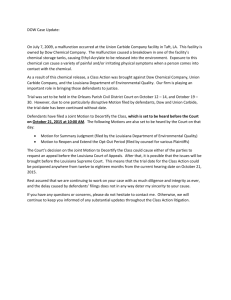
![Word version [Proposed] Order Relating and - E](http://s3.studylib.net/store/data/007179148_1-21c58ae88204e7aa5a7a5320a59522e5-300x300.png)
